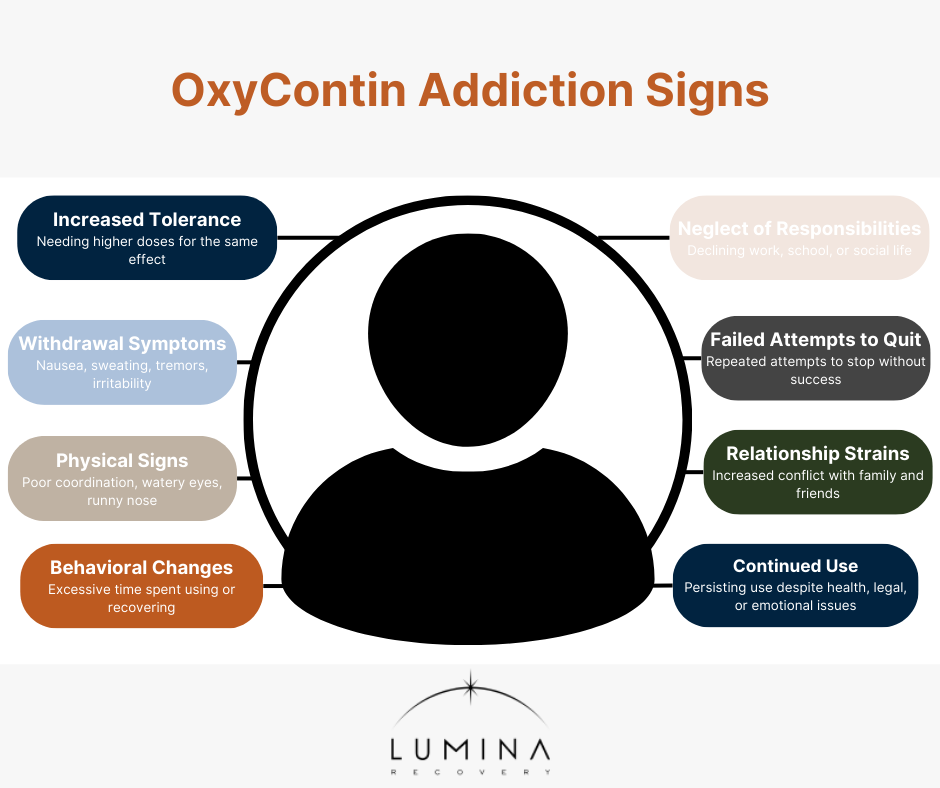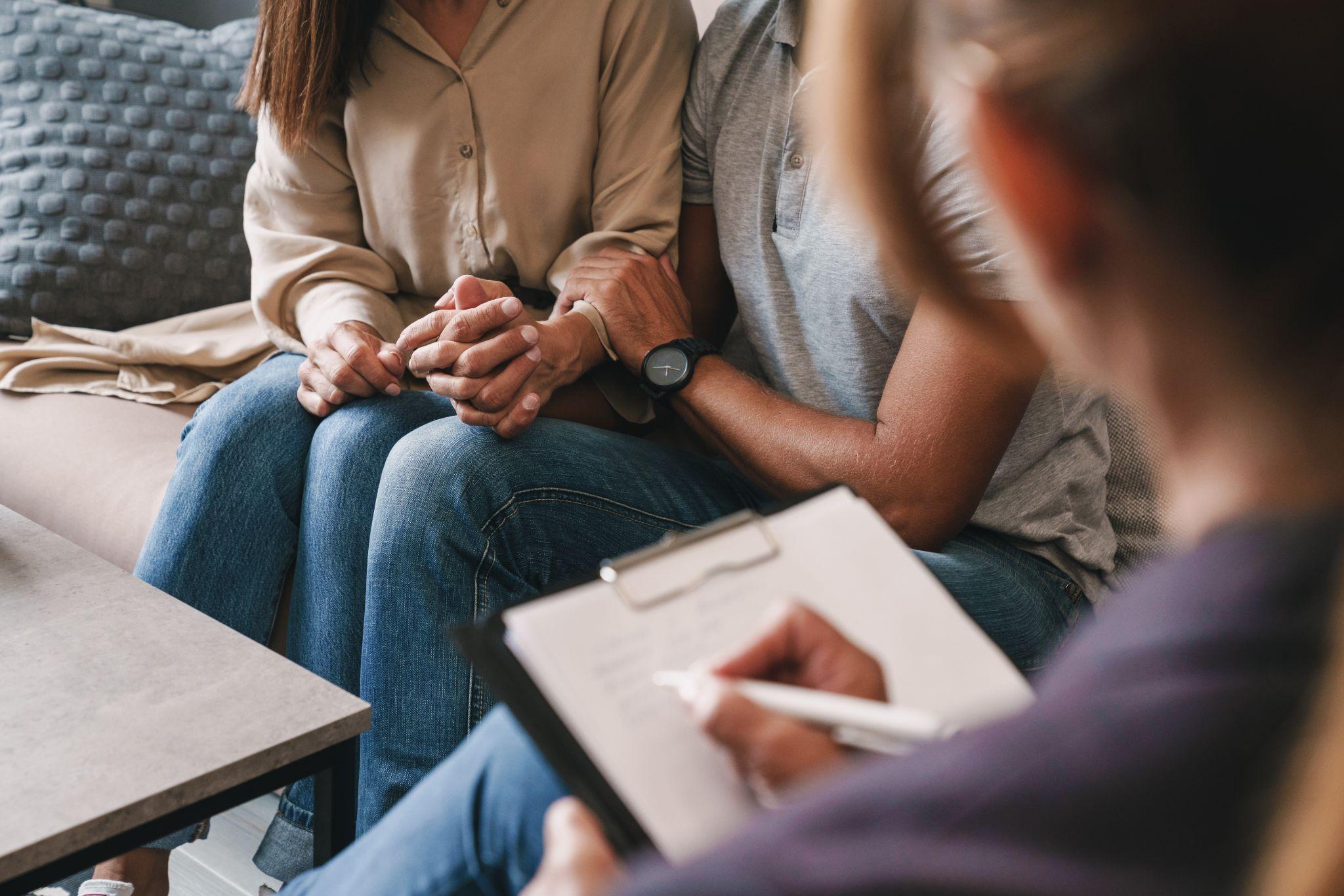OxyContin is a brand-name prescription opioid containing oxycodone, commonly prescribed for severe pain management. While effective for short-term relief, its potent narcotic properties make it highly addictive, even when taken as directed.
OxyContin impacts the nervous system and brain by altering how they respond to pain, creating a euphoric and calming effect. Over time, individuals may develop both physical and psychological dependence, leading to addiction.
Understanding the signs of oxycodone abuse, symptoms of use, and addiction risks is critical for early intervention and recovery support.
OxyContin and Opioid Addiction Statistics
Opioid addiction continues to be a public health crisis in the United States. In 2020, over 48,000 people lost their lives to opioid overdoses, reflecting the devastating toll of this epidemic. Misuse of opioids is also widespread, with 3.8% of American adults abusing them each year.1
Alarmingly, opioids are involved in the majority of overdose deaths, with at least 71.8% and as many as 80% of fatalities linked to these substances. These statistics highlight the urgent need for awareness, prevention, and accessible treatment options to combat this crisis.1
OxyContin Addiction vs. Dependence
The difference between addiction and dependence is an important factor in determining effective treatment.
- Dependence: This is a physical reliance on oxycodone that develops over time as the body adapts to the drug. Dependence can result in withdrawal symptoms when use stops but does not necessarily involve compulsive behaviors.
- Addiction: Addiction is a chronic disorder characterized by compulsive drug-seeking behavior, psychological cravings, and continued use despite negative consequences. Addiction often involves significant lifestyle disruptions and difficulty controlling use.
While both conditions require treatment, addiction typically involves more extensive behavioral and psychological support to address underlying causes.
OxyContin Addiction Signs
Recognizing oxycodone addiction signs early can prevent long-term harm. Key signs include:2
- Increased Tolerance: Requiring larger amounts of OxyContin to feel the same level of relief or effect as before.
- Withdrawal Symptoms: Facing symptoms like nausea, sweating, tremors, and irritability when the drug is not taken.
- Physical Signs: Impaired coordination, unexplained injuries, watery eyes, and a runny nose may indicate oxycodone symptoms of use.
- Behavioral Changes: Spending excessive time obtaining, using, or recovering from OxyContin.
- Neglect of Responsibilities: Declining performance at work or school and avoiding hobbies or social activities.
- Failed Attempts to Quit: Repeatedly trying and failing to stop using the drug.
- Relationship Strains: Increased conflicts with loved ones due to signs of oxycodone
- Continued Use Despite Problems: Persisting in use even when it causes health issues, legal troubles, or emotional distress.
Risk Factors for Oxycodone Addiction
Certain factors increase the likelihood of developing an addiction to oxycodone, including:
- Genetic Predisposition: Having a family history of substance abuse may increase the likelihood of developing similar problems.
- Environmental Influences: Growing up in an environment where drug use is common can predispose individuals to addiction.
- Mental Health Disorders: People with mental health issues such as depression, anxiety, or post-traumatic stress disorder (PTSD) may be at higher risk of addiction as they may use OxyContin as a form of self-medication.
- Chronic Pain: Individuals prescribed OxyContin for long-term pain management face a higher risk of addiction, especially without proper medical supervision.
- Previous Substance Abuse: Individuals who have a history of abusing other substances may be more likely to develop an addiction to OxyContin.
- Social and Economic Problems: Stressful life circumstances such as unemployment or lack of social support can contribute to the onset of addiction.
5 Steps to Get Help for OxyContin Addiction
Taking action is essential to overcoming oxycodone addiction symptoms and reclaiming your life. Follow these steps:
- Recognize the problem. The first step is acknowledging the issue. Educate yourself on the signs of oxy addiction and assess whether you or a loved one might be struggling.
- Seek professional detox. A medically supervised detox ensures that withdrawal symptoms are managed safely. Attempting to detox at home can be dangerous and is not recommended.
- Explore medication-assisted treatment (MAT). MAT combines FDA-approved medications like buprenorphine or methadone with counseling to reduce cravings and stabilize recovery. MAT is a proven approach to managing both the physical and psychological aspects of addiction.
- Commit to therapy. Therapy is essential for addressing the root causes of addiction. Cognitive behavioral therapy (CBT) helps individuals identify and change harmful thought patterns, while dialectical behavior therapy (DBT) supports emotional regulation. Family therapy strengthens relationships and builds a supportive recovery environment, providing a holistic approach to overcoming addiction.
- Join support groups. Support groups like Narcotics Anonymous (NA) offer peer connections and accountability. Sharing experiences with others who understand your journey can provide ongoing motivation and support.
Holistic Approaches to Recovery
Incorporating holistic therapies into your recovery plan can improve your mental and physical health, making long-term sobriety more attainable. Activities such as yoga, meditation, and regular exercise promote relaxation, reduce stress, and encourage a balanced lifestyle. These practices complement traditional treatments and enhance overall well-being.
In addition to physical wellness, holistic approaches also focus on emotional and spiritual healing. Creative outlets like art therapy, music therapy, and journaling can help individuals process emotions and build healthier coping mechanisms.
Engaging in mindfulness practices or spending time in nature can further support emotional regulation, improve self-awareness, and provide a sense of inner peace during the recovery journey.
Frequently Asked Questions (FAQs)
1. How does OxyContin make you feel?
OxyContin can create feelings of euphoria, relaxation, and pain relief, but it can also lead to drowsiness, confusion, and, with misuse, addiction.
2. What does OxyContin do to the brain?
OxyContin binds to opioid receptors in the brain, altering how pain is perceived and triggering the release of dopamine, which reinforces drug-seeking behavior.
3. What does OxyContin look like?
Being able to identify OxyContin is important. The drug is available in tablet form, typically round or oval-shaped, and comes in different colors depending on the dosage. It often has an imprint indicating the strength and brand.
4. What are the early signs of oxycodone addiction?
Early oxy symptoms include increased tolerance, withdrawal symptoms, neglect of responsibilities, and persistent cravings.
Reclaim Your Life From OxyContin Addiction With Lumina Recovery
OxyContin addiction can disrupt lives, but recovery is possible with the right support and treatment. Recognizing the signs and risk factors for oxycodone addiction and taking proactive steps toward treatment can provide hope for those ready to recover.
Our medically supervised detox program ensures a safe and supportive withdrawal process, while our specialized treatment for prescription drug and opioid addiction addresses both the physical and psychological aspects of dependency. Through evidence-based therapies and personalized care, we help individuals break free from addiction and regain control of their lives.
Start your recovery journey today. Contact us to learn how we can support you or your loved one in overcoming OxyContin addiction and building a healthier future.
Sources:




